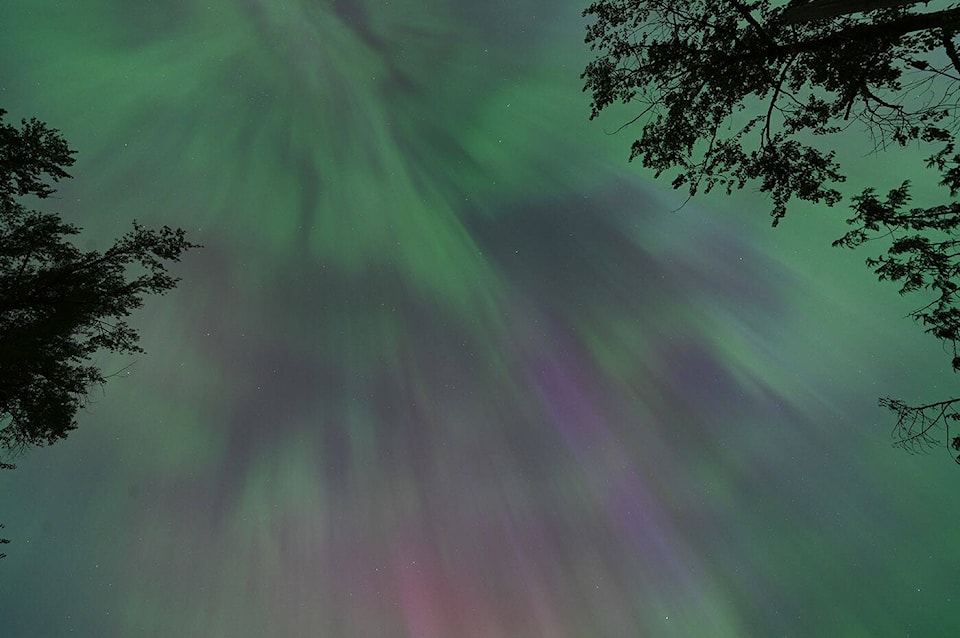Millions of people are now able to see the Northern Lights first-hand, as smartphone cameras can now see the invisible.
Many years ago, my roller derby teammates and I went on an adventure to Alaska in the dead of winter. The match itself was what I was most looking forward to, but the chance of seeing the Northern Lights would be a close runner-up.
It was December, the height of the aurora season, but I couldn't see anything. It's not a bright bundle of light. It's not a little green swirl. Nada.
Very disappointed.
After more than 12 years, the light was supposed to come to me this time. On Friday, May 10th, a solar storm brought the Northern Lights to British Columbia.
I headed down Chilliwack's Old Orchard Road (which hugs the majestic Fraser River) and hunkered down with about eight other people with my tripod and full-frame mirrorless camera just before 11 p.m.
Eventually I saw a faint white vertical line heading north. As time went on, more lines appeared, but it wasn't the very bright green or purple that I saw in many photos – not to my naked eye anyway .
However, when I saw the image on the camera's LCD screen, I was astonished. A bright lime green light shot through my frame. Magenta movement filled each image.
Photo: People enjoy the spectacular Northern Lights show in the Fraser Valley
 The Northern Lights seen from Old Orchard Road in Chilliwack on Friday, May 10, 2024. (Jenna Hawk/Chilliwack Progress)
The Northern Lights seen from Old Orchard Road in Chilliwack on Friday, May 10, 2024. (Jenna Hawk/Chilliwack Progress)
Our eyes can't see well in low light, so the aurora borealis are usually not very vivid to the naked eye. On the other hand, a camera can capture much more light into a single image than our eyes can see.
If I had brought a professional camera to Alaska, I probably would have witnessed this incredible sight in 2012.
This was the first extreme solar storm in our area in years. Earlier on May 10, the National Oceanic and Atmospheric Administration announced its first geomagnetic storm watch since 2005, saying the storm would be a “potentially historic event.”
Later on, I realized that the reason why this phenomenon is so spectacular and so overwhelming to so many people is technology.
The first iPhone was released in 2007, and it certainly wasn't capable of capturing night images.
But now you can do it with your smartphone too.
Today, millions of people can witness the Northern Lights firsthand. Because they have the tools to see things that our eyes can't see.
Friday night, Mother Nature's show started out dimly, visible only in my immediate surroundings, but slowly but surely the sky began to brighten a little.
People pointed and looked up. By 11:30 p.m., the night sky was definitely taking on shades of purple and green.
And even though the lights were more visible to the naked eye than when I first arrived, the aurora borealis still weren't as spectacular as they were on camera.
The 8-30 second exposure captured much more than what my photographer's eyes saw that night.
I have always considered myself lucky to have witnessed and recorded many events around Chilliwack, but this one was even more so.
And from what I saw on social media that night and afterward, the people of Chilliwack were just as lucky as I was because of technology.
Jenna Hauck is an award-winning multimedia journalist who has been with the Chilliwack Progress since 2000. For more of her Northern Lights photography, check out her slide show online.
 The Northern Lights are seen over the Fraser River on Old Orchard Road in Chilliwack on Friday, May 10, 2024. (Jenna Hawk/Chilliwack Progress)
The Northern Lights are seen over the Fraser River on Old Orchard Road in Chilliwack on Friday, May 10, 2024. (Jenna Hawk/Chilliwack Progress)
Source link



